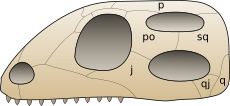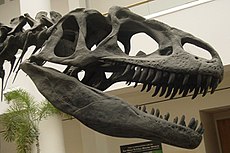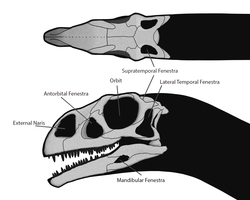Diapsida
Ein Diapsid ist ein Reptil mit zwei Fenestrae (Löchern) hinter dem Auge auf jeder Seite seines Schädels. Die meisten Reptilien sind Diapsidien, und die Krankheit kommt bei Säugetieren nicht vor. Die Funktion der Löcher besteht darin, die Kieferbewegungen zu verbessern und das Gewicht des Schädels zu verringern. Die Löcher bieten Platz für die Anbringung von Muskeln; wenn sich die Kiefermuskeln zusammenziehen, lassen die Löcher auch Platz für die Auswölbung der Muskeln.
Der Allosaurus-Schädel zeigt, wie der Schädel bei Dinosauriern, insbesondere bei den großen Theropoda, heller wurde. Er ist hier nicht viel mehr als eine Reihe von Streben, bietet aber dennoch massive Bisskraft.

Allgemeines Schema des Diapsidschädels. Beachten Sie die beiden Löcher im Schädel hinter dem Auge

Allosaurus-Schädel

Dieser Massospondylus-Schädel zeigt die beiden für Diapsidien typischen temporalen Fenestrae sowie das antorbitale Fenestra vor den Augen.
Euryapsidien
Einige Gruppen aquatischer Reptilien verloren die untere der beiden Öffnungen und ließen nur noch eine hinter dem Auge zurück. Dies nennt man den euryapiden Zustand. Es ist ziemlich sicher, dass dies sekundär ist und dass die Gruppen ursprünglich diapsidisch waren. Die Gruppen umfassen:

Ein euryapsidischer Schädel
Fragen und Antworten
Q: What is a Diapsid?
A: A Diapsid is a type of reptile that has two fenestrae or holes behind each eye on both sides of its skull.
Q: What is the main function of the Diapsid's holes?
A: The holes provide space for muscle attachment, allowing improved jaw movements and reducing the weight of the skull.
Q: Do mammals have the condition of Diapsids?
A: No, the condition of Diapsids does not occur in mammals.
Q: How do the Diapsid's holes contribute to jaw movements?
A: The holes give places for muscle attachment, and as jaw muscles contract, they allow space for the muscles to bulge, improving jaw movements.
Q: What is the significance of the Allosaurus skull in Diapsid evolution?
A: The Allosaurus skull provides evidence of how the skull became lighter in dinosaurs, especially large theropods, yet still managed to provide massive bite power.
Q: Are most reptiles considered Diapsids?
A: Yes, most reptiles are classified as Diapsids.
Q: Why is reducing the weight of the skull important for the Diapsid?
A: Reducing the weight of the skull allows the Diapsid to use less energy when moving its head, improving its overall mobility and efficiency.
Suche in der Enzyklopädie